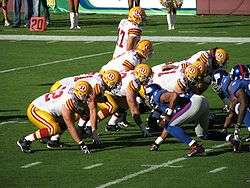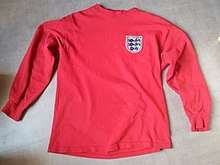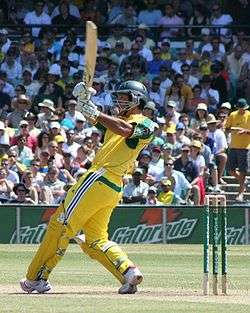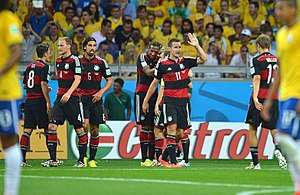Away colours
Away colours are a choice of coloured clothing used in team sports. They are required to be worn by one team during a game between teams that would otherwise wear the same colours as each other, or similar colours. This change prevents confusion for officials, players, and spectators. In most sports, it is the visiting or road team that must change – second-choice kits are commonly known as away kits or change kits in British English, and road uniforms in American English.

Some sports leagues mandate that away teams must always wear an alternative kit, while others simply state that the two teams' colours should not match. In some sports, conventionally the home team has changed its kit (such as in rugby union and early association football).
In most cases, a team wears its away kit only when its primary kit would clash with the colours of the home team. However, sometimes teams wear away colours by choice, occasionally even in a home game. At some clubs, the away kit has become more popular than the home version. Replica home and away kits are usually available for fans to buy. Some teams also have produced third-choice kits, or even old-fashioned throwback uniforms.
In North American sports, road teams typically wear a change uniform regardless of a potential colour clash. "Color vs. color" games (e.g., blue jerseys vs. red jerseys) are a rarity,[1] having been discouraged in the era of black-and-white television.[2] Almost all road uniforms are white in gridiron football (including in the Canadian Football League, the National Football League and NCAA football) and the National Hockey League, while in baseball, visitors typically wear grey. In the National Basketball Association and NCAA basketball, home uniforms are white or yellow, and visiting teams wear the darker colour.
American football
National Football League
Most teams often wear their "official team colour" at home, with the road team wearing white in most cases.[2] White road uniforms gained prominence with the rise of television in the 1950s. A "white vs. colour" game was easier to follow in the black-and-white television era.[2] According to Phil Hecken, "until the mid 1950s, not only was color versus color common in the NFL, it was actually the norm."[2] Even long after the advent of colour television, the use of white jerseys has remained in almost every game because some fans may still use black-and-white television.
The NFL's current rules require that a team's home uniforms must be "either white or official team colour" throughout the season, "and visiting clubs must wear the opposite".[3] If a team insists on wearing its home uniforms on the road, the NFL Commissioner must judge on whether their uniforms are "of sufficient contrast" with those of their opponents.[3] The road team may instead wear a third jersey, such as the Seattle Seahawks' "Wolf Grey" alternate.
White at home, colour away
According to the Gridiron Uniform Database, the Cleveland Browns wore white for every home game of the 1955 season.[4] The only times they wore brown was for games at Philadelphia and the New York Giants, when the Eagles and Giants chose to wear white.
In 1964 the Baltimore Colts, Cleveland Browns, Minnesota Vikings and Los Angeles Rams wore white regularly for their home games according to Tim Brulia's research.[5] The St. Louis Cardinals wore white for several of their home games, as well as the Dallas Cowboys; while most teams switched back to colours the next year, the Rams and Browns still regularly wore white until the 1970s.
Until 1964, Dallas had worn blue at home, but it was not an official rule that teams should wear their official colours at home. The use of white jerseys was introduced by general manager (GM) Tex Schramm, who wanted fans to see a variety of opponents' jersey colours at home games.[6][7] The Cowboys still wear white at home today.

White has also been worn regularly at home by the Miami Dolphins, Washington Redskins, Philadelphia Eagles, and several other NFL teams.[5] Teams in cities with hot climates often choose white jerseys at home during the first half of the season,[8] because light colours absorb and retain less heat in sunlight – as such, the Dolphins, who stay white year-round, will typically use their coloured jerseys for home night games.[9] Every current NFL team except the Seattle Seahawks has worn white at home at some time in its history.[5]
During the successful Joe Gibbs era, Washington chose to wear white exclusively at home in the 1980s and 1990s,[5] including the 1982 NFC Championship Game against Dallas. Since 2001, they have chosen to wear white jerseys and burgundy jerseys roughly equally in their home games, but they still wear white against the Cowboys.[5] When Gibbs returned from 2004 to 2007, they wore white at home exclusively. In 2007, they wore a white throwback jersey.
The Dallas Cowboys' blue jersey has been popularly viewed to be "jinxed" because of defeats at Super Bowl V in 1971 (when they were assigned to wear their blue jerseys as the designated 'home' team[10]), and in the 1968 divisional playoffs at Cleveland, Don Meredith's final game as a Cowboys player. Dallas's only victory in a conference championship or Super Bowl wearing the blue jerseys was in the 1978 NFC Championship game at the Los Angeles Rams.
Super Bowl rules later changed to allow the designated home team to pick their choice of jersey. White was chosen by the Cowboys (XIII, XXVII), the Redskins (XVII), the Pittsburgh Steelers (XL), the Denver Broncos (50), and the New England Patriots (LII).[11] The latter three teams normally wear colours at home, but Pittsburgh had worn white in three road playoff wins, while Denver cited its previous Super Bowl success in white jerseys (XXXIII), while being 0–4 when wearing orange in Super Bowls.
Occasionally, teams playing against Dallas at home wear their white jerseys to attempt to invoke the "curse",[12] as when the Philadelphia Eagles hosted the Cowboys in the 1980 NFC Championship Game.[13] Teams including the St. Louis Cardinals and New York Giants followed suit in the 1980s, and the Carolina Panthers did so from 1995 until 2006, including two playoff games. The Houston Texans did so in 2002, beating Dallas in their inaugural regular season game. More recently, the Patriots and then-St. Louis Rams tried the same tactic.[14][15]
The originator of white home jerseys in the NFL at Dallas, Tex Schramm, said he did not believe in the curse.[16]
Starting in 2014, the Panthers, who like many teams typically switch from white to colour in October or November, have worn white at home in the postseason regardless of their opponent; the franchise has never won a playoff game while wearing coloured jerseys, including in Super Bowl 50, when the Broncos (as the designated "home" team) chose to wear white.
While they had only done so twice, both to "jinx" Dallas, during the 21 years they played in St. Louis, since returning to Los Angeles in 2016, the Rams, temporarily playing in the same stadium as they had in the 1960s, have worn white at home as a conscious tribute to the highly successful teams of that era.[17]
Other leagues
Coloured road uniforms were used in the World Football League (WFL) during its short period of existence in 1974–75, with the home team wearing white,[18] and college football teams must base their road uniform around a white jersey.[19]
Association football

While a team's primary kit rarely undergoes major changes, the second colours tend to vary over time and sometimes by tournament. Some away kits are a modification of the home colours (for example a reversal of primary and secondary colours), other away kits are considerably different from home kits.
Several club and national sides have favourite away colours which might remain the same more or less continuously. Often these are colours that were used in famous victories; for instance Brazil (blue) and A.C. Milan (white). Many professional clubs also have an official third kit.[20]
Some teams opt to wear their away colours even when not required to by a clash of colours. England sometimes play in red away shirts, as the team wore red when it won the 1966 World Cup.[21] A.C. Milan chose to wear all-white in the 2007 UEFA Champions League Final as they considered it their "lucky shirt" (Italian: maglia fortunata).[22]
In some title-deciding matches, a team has won the game wearing its away kit, but changed to home shirts for the trophy presentation – most notably when Spain won the 2010 World Cup final, changing from dark-blue away to red home shirts to lift the trophy.[23]
In some cases both teams have been forced to wear their second choice away kits; such as in some World Cup matches (see section below). During the 1998-99 UEFA Champions League, Manchester United had to wear their away colours in both of their group stage matches against F.C. Barcelona, not just away at Camp Nou but also home at Old Trafford too.
History in European football

In England in 1890, the Football League, which had been formed two years earlier, ruled that no two member teams could register similar colours, so as to avoid clashes. This rule was later abandoned in favour of one stipulating that all teams must have a second set of shirts in a different colour available.[20] Initially the home team was required to change colours in the event of a clash, but in 1921 the rule was amended to require the away team to change.[24] In 1927 the Scottish Football Association decreed a different solution, whereby home teams wore white shorts and away teams black shorts, but this rule was rescinded in 1929.[20]
It is normal for individual competitions to specify that all outfield players on a team must wear the same colours, though the Law states only "The two teams must wear colours that distinguish them from each other and the match officials".[25] In the event of a colour clash, the away team must change to a different colour.[26]
Away kits were often worn by both teams in English FA Cup matches. Until 1989–90,[27] its competition rules stated: "Where the colours of the two competing clubs are similar, both clubs must change unless alternative arrangements are mutually agreed by the competing clubs".[28] Clubs sometimes needed to find makeshift third kits for their players.[29] Many FA Cup finals were played under these rules, the last being the 1982 Final and replay. In European competition, the 1968 European Cup Final was played under similar rules.
The old FA Cup rules, with almost identical wording, are still used in semis and finals by many county and district football associations in England.[30]
FIFA World Cup

Three teams have won the FIFA World Cup final in their away colours – in 1958 (Brazil), 1966 (England), and 2010 (Spain); though England was the home team for the 1966 tournament.[21]
At international level, away kits are sometimes worn by both teams in a match. FIFA rules state, "In exceptional cases, both teams may be asked to wear different Colours" by the referee or match commissioner.[31] This is most likely to happen in World Cup matches with large numbers of black-and-white television viewers, so that the teams' kits also differ in tone (light and dark). World Cup teams often have to make changes that would be unlikely in domestic or untelevised games. In 1957 Scotland borrowed home team Switzerland's white away shirts to avoid clashing on black-and-white television.[32][33] In 1970 England and Czechoslovakia were allowed to play in sky blue and white, respectively, which caused confusion for black-and-white viewers and England manager Alf Ramsey. England reverted to red away shirts against West Germany.[34] Netherlands and Brazil played their 1974 World Cup game in white and dark blue respectively, rather than their first choices of orange and yellow.
FIFA's regulations for the 2014 World Cup "mandate that teams need to have two very distinguishable shirts – where one is a lighter colour and the other is a darker one".[35]
At the 2014 World Cup, Croatia were allowed to wear red-and-white checked shirts, instead of blue, against Brazil, only after Croatia appealed FIFA's original decision.[36] England were not allowed to wear red away shirts, and instead were made to wear white against Uruguay, due to an apparent clash with officials' uniforms.[37]
Before the 2014 tournament, FIFA decreed that Spain's all-red home kit and all-black away kit were not sufficient as they were both considered dark tones. FIFA forced Spain to produce an all-white third kit.[38][35] The match between Netherlands and Spain was played in Netherlands' dark blue away kits and Spain's white third-choice kits.
In the 2018 FIFA World Cup third place match, both Belgium and England wore their away colours of yellow and red, respectively, even though both teams were permitted to wear their respective home colours of red and white in their group stage match. Denmark and Australia also wore their away kits in a group stage match, after Danish player, Thomas Delaney revealed in a phone call to a radio station that he is colourblind.[39]
Baseball
Major League Baseball
Originally, Major League Baseball teams were primarily distinguished by the colours of their stockings. In 1882, the National League assigned different stocking colours to the member clubs; the league also assigned jersey and cap colours, but by player position rather than by club.
The Cincinnati Reds were known as the "Red Legs" and "Red Stockings" during the early 1900s.

By the end of the 19th century, it became common for teams to wear white at home, and grey in road games. Some teams used road uniforms of solid dark blue or black.[40] An early example of this is the Brooklyn Superbas, who started to use a blue pattern for their road uniforms in 1907.[40] Both the home and away teams' uniforms also contained trim in the team colours.
In 1916, on the New York Giants' road uniforms, purple lines gave their uniforms a tartan-like effect and another kind of road uniform was a solid dark blue or black material with white around this time. The Kansas City Athletics home and road uniforms were changed by Charles O. Finley in 1963, to the colours of gold and green.[41] Some teams used powder blue for their road uniforms from the 1970s to the early 1990s.[40]
Aside from the obvious need to distinguish one team from the other, conventional wisdom held that it was more difficult to properly launder uniforms while on a road trip, thus the "road grays" helped to hide accumulated soil. This convention continued well after its original premise was nullified by the issuance of multiple uniforms and the growth of the laundromat industry.
Typically, home uniforms feature the team's nickname, while away uniforms feature the name of the team's geographic designation; there are eight teams that are exceptions to this rules: the Tampa Bay Rays, Los Angeles Angels, Philadelphia Phillies, St. Louis Cardinals, Washington Nationals, Miami Marlins, Detroit Tigers and New York Yankees.[42]
The Cardinals, Phillies, Rays and Angels wear their team nickname on both home and away jerseys, although the Cardinals now wear alternates with the city name. The Marlins' home and away jerseys feature the city name, but a black alternate has the team nickname.
The Tigers, Nationals and Yankees all wear their cap insignia on the left breast of their home jerseys, but the city name on their away jerseys.
In addition to this, some teams have featured mainly their team's location presented on their uniforms both at home and on the road. Examples include the Rangers and Marlins, whose alternate orange jersey is the only one of the team's four to feature the nickname instead of the city or state name. Some teams have alternate home uniforms featuring location such as the Colorado Rockies and St. Louis Cardinals. The Brewers have worn a navy jersey with "Milwaukee" on the front frequently both at home and on the road since 2015, while the Los Angeles Dodgers have worn an alternate grey jersey with the nickname instead of the city name for most away games since 2014.
From 1973 to 2008, the Baltimore Orioles were part of this group – the omission of the city's name being part of a largely successful effort to attract fans from the Washington, D.C. area – before returning "Baltimore" to the road jerseys in 2009, by which time their neighbour 35 miles (55 km) to the south once again had a team of its own.
Basketball

Until the 2017–18 season, the rules of the National Basketball Association (NBA) stated: "The home team shall wear light color jerseys, and the visitors dark jerseys unless otherwise approved. For neutral court games and doubleheaders, the second team named in the official schedule shall be regarded as the home team and shall wear the light colored jerseys."[43] Most teams' home uniforms are white, with some exceptions, such as the Los Angeles Lakers, who wear gold at home (although in 2002, to honour Chick Hearn, Jeanie Buss had a white jersey introduced as the third uniform, worn at home). But, according to this rule, road uniforms are required at every game in the NBA. "Dark" colours worn in road games vary widely among teams.[44]
Beginning with the 2017–18 season, the home team is allowed to designate whether it will wear a white or coloured jersey. The visiting team must wear a jersey of sufficient contrast, whether it be white or another colour.[45]
The use of specially-designed Christmas uniforms in NBA games in 2012[46][47] led to several "color vs. color" match-ups.[48]
In NCAA Division I college basketball, the home team almost universally wears white uniforms, while the visiting team wears colours. There are exceptions, such as the University of Michigan, Louisiana State University and West Virginia University wearing yellow at home, or the University of Illinois wearing orange at home, if it sufficiently contrasts with the visiting team's uniforms.
Cricket

Away kits are a recent development in cricket, which has been played in all-white clothing for most of its history. The first professional match played in coloured clothing was in World Series Cricket in Australia in 1979. The first Cricket World Cup to use coloured kits was the 1992 tournament.
The England team uses one kit for all home and away ODI and Twenty20 matches.[49] India also uses a light blue kit for both.[50]
Australia, however, has a separate green ODI home kit, yellow ODI away kit, and black T20 kit.[51][52] The home kit is the same colour as the famous "baggy green" cap traditionally worn by Australian Test cricketers, but the yellow away kit is often worn by the Australian team in home matches.
In 2019 Cricket World Cup the Indian cricket team has used the orange dark blue combination jersey to differentiate from the home team England.
Ice hockey
National Hockey League

In the NHL each team is currently required to have two uniform designs: one with a white base (or sometimes historically, a light colour), and one with a darker-coloured base. From the 1970–71 season to the 2002–03 season, NHL teams wore lighter colours or white at home and the darker colours on the road. When the Third Jersey Program was introduced in the 1995–96 season, some teams wore third jerseys at home, thus requiring the road team to wear the white. This problem was rectified at the start of the 2003–04 season, as NHL teams started to wear the dark colour at home and the white for road games; there are occasional single-game exceptions.[53][54] The only element allowed by NHL rules to be interchangeable between the two uniforms is the pants.
In the minor leagues, teams historically wore white or light colours at home and dark colours on the road.
Original hockey jerseys were actually heavily knit sweaters. They were light colour for home games and a dark colour for road games. The reason dark-coloured sweaters were part of the "road" uniform was to hide the dirt the sweaters accumulated. The sweaters were not washed during road trips. The light or white sweaters were "home" uniforms as the visiting teams necessarily wore the dark. This tradition fit the needs of "home/away" distinctions necessary for B&W television.
Netball
Away colours are used by Jamaica and Australia, two top international teams who both have yellow home kits. Jamaica's change kit is all-black, Australia's is all-green. When the teams meet, one usually changes its kits[55][56][57] but there have been games such as a 2011 Test where each team wore predominantly yellow, with Jamaica in black skirts.[58]
Alternate colours are also used where required in the Australasian ANZ Championship.
Rugby union

It is traditional in rugby (as it was in association football prior to 1921) for the home team to change in the event of a clash. This stems partly from teams touring overseas; it was easier for the home side to get an alternate kit. The World Rugby rules for tours do not state this outright: it is the responsibility of the WR CEO or representative "to resolve the matter", but "in the absence of any agreement to the contrary, the Host Union shall be entitled to wear its home kit."[59] In English RFU level 3 to 5 competition, if there is a clash the away team must change.[60]
At Rugby World Cups, colour clashes are decided by a coin-toss for first choice of kits. In the 2007 quarter-final between France and New Zealand, the recently redesigned French kit was dark blue and black, and clashed with the All Blacks' kit.[61] The toss went in favour of France, and New Zealand wore silver shirts in the game in Cardiff.[62] However, in the 2011 Rugby World Cup Final between those teams, France won the toss and chose to play in its white away kit. France's team manager Jo Maso said this decision was because of "the welcome they’d received from the people of New Zealand, the faultless organisation of the tournament and the honour and pleasure of playing... [at] Eden Park".[61]
England used an all-black second kit at the 2011 World Cup, which caused controversy in the host nation, as black is the home colour of New Zealand.[62] England wore the kit in one tournament match, against Argentina. Critics in England in 2010 said the team was changing away kits unnecessarily and too often as a "marketing ploy".[63] Australia, on the other hand, has rarely worn an away kit except against Romania;[64] a white jersey would have been worn in 2011.[65]
In international rugby, the need for second kits arises most often in the Six Nations, where Scotland, France and Italy all play in different shades of blue. The tournament takes the form of a single round-robin with home advantage alternating each year, and it is scheduled so that each of the three aforementioned sides plays one of the other two at home and the other away in a given season. In turn, this means that each of these three sides will play one home game in its alternate jersey. These have traditionally been white, but in the 2015 Six Nations Scotland and France adopted red as their alternate colour.[66][67]
International rules
Ireland's green jersey is complemented by two away jerseys, one which is white in colour and one which is navy in colour.[68]
See also
References
- "Mets and Braves wearing color vs color" Archived 6 March 2013 at Wikiwix, SportsLogos.net, 2009 (Retrieved 5 March 2013)
- "NFL Color vs. Color – Part I" Archived 28 November 2012 at the Wayback Machine, "Part II: Back to the Future" Archived 14 September 2012 at the Wayback Machine, "Part III: A Modest Proposal" Archived 14 December 2013 at the Wayback Machine, Phil Hecken, 2010 (Retrieved 3 March 2013)
- "Section 4: Equipment, Uniforms, Player Appearance" (PDF). National Football League. 29 August 2012. Retrieved 5 January 2016.
- "1955 Season – Week 1". The Gridiron Uniform Database. Archived from the original on 10 October 2016. Retrieved 7 October 2016.
- Brulia, Tim. "White at Home in the NFL". Uni Watch. Archived from the original on 9 July 2013. Retrieved 12 June 2013.
- Eatman, Nick (26 November 2013). "Cowboys To Wear Blue Jerseys at Home Thursday". Dallas Cowboys. Archived from the original on 2 October 2015. Retrieved 7 October 2015.
Since the days of former GM Tex Schramm, whose vision was to give the home fans a different look each week, the Cowboys have traditionally worn white at home. Schramm didn't like the idea that fans would say the home blue jerseys vs. a white road team every Sunday, so Philadelphia's green or the Cardinals’ red or the Giants’ blue would mix up the color pattern on a weekly basis.
- Lukas, Paul. "The Island of Misfit Unis". ESPN. Archived from the original on 1 July 2010. Retrieved 28 November 2007.
- Kaboly, Mark (28 October 2009). "NFL teams turning back to white jerseys". Pittsburgh Tribune-Review. Archived from the original on 11 February 2015. Retrieved 12 June 2013.
- Lukas, Paul (19 September 2005). "What can white do for you?". ESPN. Archived from the original on 1 September 2013. Retrieved 12 June 2013.
- Lukas, Paul (26 October 2007). "ESPN Page 2 – Uni Watch: How 'bout them Cowboys?". ESPN. Archived from the original on 12 July 2008. Retrieved 28 November 2008.
- Swanson, Ben (25 January 2016). "Broncos to wear white uniforms in Super Bowl 50". DenverBroncos.com. NFL Enterprises, LLC. Archived from the original on 26 January 2016. Retrieved 25 October 2018.
- Williams, Charean (22 November 2001). "Cowboys going with retro look". Fort Worth Star-Telegram.
- Wallace, William (7 January 1981). "EAGLES DEVISE COLOR SCHEME FOR COWBOYS". The New York Times. Retrieved 25 October 2018.
- Rapoport, Ian (14 October 2011). "Patriots coach Bill Belichick talks about the Cowboys curse of the blue jerseys… and "striped shoelaces?"". Boston Herald. Archived from the original on 7 December 2011. Retrieved 25 October 2018.
- Young, Shalise Manza. "Visitors will be forced to cope with a case of the blues". Boston Globe. Archived from the original on 19 October 2011. Retrieved 25 October 2018.
- "Cowboys to Wash Out Blue". The New York Times. Associated Press. 15 January 1981. Retrieved 25 October 2018.
- 3k (11 August 2016). "2016 Los Angeles Rams Will Wear White Uniforms at Home". TurfShowTimes.com. Retrieved 25 October 2018.
- "World Football League Road Uniforms – The Football Uniform Site". oursportscentral.com. Archived from the original on 30 June 2013. Retrieved 4 May 2018.
- The 20 Best Road Uniforms in College Football Archived 17 July 2012 at Wikiwix, Bleacher Report, 1 April 2012. Retrieved 16 July 2012
- David Moor. "A Brief History of Football Kit Design in England and Scotland". HistoricalFootballKits.co.uk. Archived from the original on 18 January 2008. Retrieved 14 January 2008.
- Glen Isherwood; et al. "England's Uniforms – Player Kits". England Football Online. Archived from the original on 15 January 2008. Retrieved 23 January 2008.
England sometimes choose to wear their red at home even though they could wear their white, as against Germany in the last match played at Wembley Stadium. The Football Association wished to invoke the spirit of 1966, when, in their finest moment at Wembley, England beat West Germany in the World Cup final wearing their red shirts.
- "All white for Milan in Athens". UEFA. 4 May 2007. Retrieved 21 June 2010.
- "Spain Wins 2010 World Cup" Archived 12 August 2012 at the Wayback Machine, AOL News, 11 July 2010. Retrieved 16 July 2012
- Cox, Richard; Dave Russell; Wray Vamplew (2002). Encyclopedia of British Football. Routledge. p. 74. ISBN 0-7146-5249-0.
- "Laws of the Game 2018/2019". FIFA. Retrieved 6 June 2018.
- "Standardised League Rules". Wessex Football League. Archived from the original on 6 March 2008. Retrieved 16 January 2008.
- HFK – News & Updates Archive 2011 Archived 24 June 2012 at the Wayback Machine Retrieved 16 July 2012
- "Liverpool v Arsenal 1971 FA Cup Kits" Archived 24 May 2013 at the Wayback Machine(Menu) Archived 14 July 2012 at the Wayback Machine John Devlin, True Colours Football Kits, 19 October 2008. Retrieved 17 July 2012
- Third Kits – A history of the Third Kit, John Devlin, Umbro.com, 1 September 2009
- "RULES OF THE LONDON FOOTBALL ASSOCIATION COUNTY CUP COMPETITIONS 2013–14". London Football Association. Archived from the original on 3 May 2014. Retrieved 25 August 2013.
- "Heavy Woollen District Football Association 2010/11" (PDF). Archived (PDF) from the original on 3 May 2014. Retrieved 25 August 2013.
- "WEST RIDING COUNTY SENIOR CUP COMPETITION 2011/12". West Riding FA. Archived from the original on 3 May 2014. Retrieved 25 August 2013.
- "WEST RIDING COUNTY FOOTBALL ASSOCIATION LTD Official Handbook Season 2009–2010" (PDF). West Riding FA. Archived from the original (PDF) on 3 May 2014. Retrieved 25 August 2013.
- "Prostar Cup rules". Barkston Ash District Football Association. Archived from the original on 3 May 2014. Retrieved 25 August 2013.
- "Senior Challenge Cup Rules". Leeds Football Association. Archived from the original on 3 May 2014. Retrieved 25 August 2013.
- "Uhlsport Hellenic League". Archived from the original on 7 September 2013. Retrieved 25 August 2013.
- Article 65, Equipment Regulations Archived 15 February 2017 at the Wayback Machine, FIFA, March 2010. Retrieved 16 July 2012
- Ashdown, John (5 October 2011). "Which teams have had to wear their opponents' kit?". The Guardian. Archived from the original on 2 June 2014. Retrieved 2 June 2014.
- Seal, Brian. "19 May 1957 – Scots in Swiss Clothing". Blogspot. This Day in Football History. Archived from the original on 2 June 2014. Retrieved 2 June 2014.
- "Curious tales of World Cup shirts". FIFA. Archived from the original on 30 May 2014. Retrieved 2 June 2014.
- Wright, Chris (28 May 2014). "FIFA Force Spain To Prepare 'Emergency' White Kit For World Cup Due To Baffling Holland Kit Clash Fear". Who Ate All The Pies. Archived from the original on 31 May 2014. Retrieved 2 June 2014.
- "Croatia allowed to wear their famous checkered home shirt at the World Cup opener". Football-shirts.co.uk. Archived from the original on 5 June 2014. Retrieved 2 June 2014.
- Lipton, Martin (9 May 2014). "England forced to wear all-white kit throughout World Cup group stages after FIFA meeting in Zurich". Daily Mirror. Archived from the original on 14 July 2014. Retrieved 7 July 2014.
- Muller, Alex (27 May 2014). "Adidas Release Emergency Spain Third Shirt For World Cup 2014". World Soccer Talk. Archived from the original on 2 June 2014. Retrieved 2 June 2014.
- Seales, Rebecca (11 July 2018). "Why millions of football fans see the World Cup like this". Retrieved 8 January 2020.
- "Baseball Uniforms of the 20th Century by Baseball Almanac". Baseball Almanac. Archived from the original on 9 May 2008. Retrieved 2 May 2008.
- "Charlie Finley: Baseball's Barnum". Time. 18 August 1975. Archived from the original on 12 October 2008. Retrieved 28 June 2008.
- Lukas, Paul. "Breaking down MLB's jersey name game". ESPN. Archived from the original on 28 April 2017. Retrieved 28 April 2017.
- "Rule 3, Section VI—Uniforms (Players Jerseys)" (PDF). Official Rules of the National Basketball Association 2014–2015. National Basketball Association. 9 December 2014. Archived (PDF) from the original on 8 December 2015. Retrieved 7 October 2015.
- Ismail (20 September 2009). "The Top NBA Road Uniforms: The Odd Numbers". Bleacher Report. Archived from the original on 9 October 2015. Retrieved 7 October 2015.
- Whitaker, Lang (18 July 2017). "NBA, Nike unveil new uniforms for 2017–18 season". National Basketball Association. Retrieved 20 October 2018.
- "NBA AND ADIDAS TO UNVEIL 'BIG COLOR' UNIFORMS FOR CHRISTMAS DAY GAMES" (Press release). National Basketball Association. 12 November 2012. Archived from the original on 8 December 2015. Retrieved 7 October 2015.
- Lukas, Paul (13 November 2012). "Confirming What We Already Knew". Uni-Watch. Archived from the original on 8 December 2015. Retrieved 7 October 2015.
- Ben Crook, December 25, 2012 Archived 4 March 2016 at the Wayback Machine Twitter. Retrieved 4 March 2013
- Official England Cricket Store Archived 17 July 2012 at the Wayback Machine, ECB.co.uk. Retrieved 16 July 2012
- India Cricket Shirts Archived 5 July 2012 at the Wayback Machine World Cricket Store. Retrieved 16 July 2012
- Cricket Clothing Archived 21 March 2012 at the Wayback Machine Onegrovesports.com.au. Retrieved 16 July 2012
- "Australia's Twenty20 side moves away from green and gold and will wear a black uniform this summer" Archived 13 October 2011 at the Wayback Machine Fox Sports, 4 October 2011. Retrieved 26 July 2012
- Phoenix Coyotes 2007–08 "Reverse Jersey Nights" Archived 15 March 2008 at the Wayback Machine
- Los Angeles Kings Uniform History Archived 12 May 2009 at the Wayback Machine
- "Johannah Curran, Australia v Jamaica World". Zimbio.com. Archived from the original on 14 September 2014. Retrieved 14 September 2014.
- "2011 World Netball Series – Day One – Verity Simmons, Sasha Lynch". ISI Photos. Archived from the original on 14 September 2014. Retrieved 14 September 2014.
- "Australia through to gold medal match against New Zealand, August 3, 2014". Netball.com.au. Archived from the original on 17 March 2015. Retrieved 14 September 2014.
- "Australia v Jamaica Game One". Zimbio.com. Archived from the original on 14 September 2014. Retrieved 14 September 2014.
- "IRB Handbook Online". Archived from the original on 6 June 2014. Retrieved 3 June 2014.
- "RFU Regulation 13.6.3: Kit, Clash of colours". Rugby Football Union. Archived from the original on 11 October 2014. Retrieved 3 June 2014.
- "N. Zealand granted French leave for All Black final". The Times. Malta. 18 October 2011. Archived from the original on 24 December 2013. Retrieved 1 August 2013.
- "England go all black for Rugby World Cup", Stuff (company), 15 July 2011. Retrieved 16 July 2012
- "England v Australia: RFU defends use of grey away kit". The Daily Telegraph. 12 November 2010. Archived from the original on 26 September 2015. Retrieved 3 June 2014.
- "Wallabies to be all white at the World Cup?". ESPNscrum. 5 May 2011. Archived from the original on 7 June 2014. Retrieved 3 June 2014.
- Payten, Iain (5 May 2011). "Wallabies all white for World Cup". The Daily Telegraph. Australia. Retrieved 3 June 2014.
- "New Scotland alternate kit unveiled (24/09/14)". ScottishRugby.org. Scottish Rugby. Archived from the original on 23 June 2015. Retrieved 23 June 2015.
- "France rugby team to wear red against Scotland". BBC Sport. 5 February 2015. Archived from the original on 11 March 2015. Retrieved 23 June 2015.
- "International Rules – GAA – Shop By Team".
External links
- Galleries of historical soccer kits: English clubs & Scottish clubs
- True Colours Football Kits history site


.svg.png)